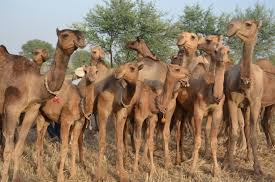INP-WealthPk
Muhammad Luqman
The Punjab Livestock Department has launched an investigation into the causes and origin of a mysterious disease that has recently killed around 10 camels across the Cholistan desert.

Talking to Wealth Pakistan, Dr Haider Ali Khan, spokesperson and Director at the Punjab Livestock Department, said that pathologists from the National Veterinary Laboratory, Islamabad, have reached the Kot Sabzal area of Rahim Yar Khan to collect blood samples from the ailing camels.
He added that a team from the Veterinary Research Institute (VRI), Lahore, has already collected samples from 52 camels for analysis.
According to Dr Khan, special teams from the livestock department have conducted medical examinations of 11,597 camels, of which only 1,100 showed symptoms of illness. These animals were immediately treated and vaccinated.
Punjab’s total camel population, according to the Agriculture Census 2024, is 252,000 — mostly concentrated in the Bahawalpur and DG Khan divisions.
Common camel diseases in Punjab include parasitic infections such as anaplasmosis (spread by ticks) and Theileria, as well as skin diseases like sarcoptic mange. Trypanosoma evansi, a protozoan disease, is also prevalent in the region. More serious ailments such as bluetongue, peste des petits ruminants (PPR), and brucellosis can also affect camels in southern Punjab.
Dr Khan said the situation is now under control, noting that no deaths have been reported during the past two days. He added that sick camels show clear improvement within two to three days after being receiving medication, and the disease does not appear to be spreading significantly.
He said five different types of medicines are being used for treatment, including those for cold, flu, and breathing difficulties.
Meanwhile, veterinarians based in Rahim Yar Khan have ruled out the possibility of any transboundary disease spreading in Cholistan.
“Had it been a disease coming from the Indian side, it would have spread across vast areas of southern Punjab. It is restricted to a small area on the Punjab-Sindh border,” Dr Muhammad Noman, Veterinary Officer in Rahim Yar Khan, told Wealth Pakistan.
He added that a vaccine can only be developed after research laboratories complete the analysis of the blood samples collected from disease hotspots.
The respiratory illness, known locally as Phuphri, currently affecting camels is similar to the one that hit the region in 2014, he said. Livestock experts have urged the Punjab government to take measures to prevent future outbreaks.
“Instead of relying on hit-and-trial treatments, the disease should be controlled permanently by developing a proper vaccine,” said Lahore-based livestock expert Dr Wasiullah Khan.
He emphasized the need for proper quarantine facilities at the Sindh-Punjab border to prevent the spread of infectious diseases among livestock.
“Punjab Livestock Department has often been caught off guard, as the Lumpy Skin Disease entered the province due to a relaxed attitude,” Dr Wasiullah added. He said the recent outbreak of a fatal camel disease in Cholistan may also have spread from elsewhere due to lack of surveillance.
Credit: INP-WealthPk












